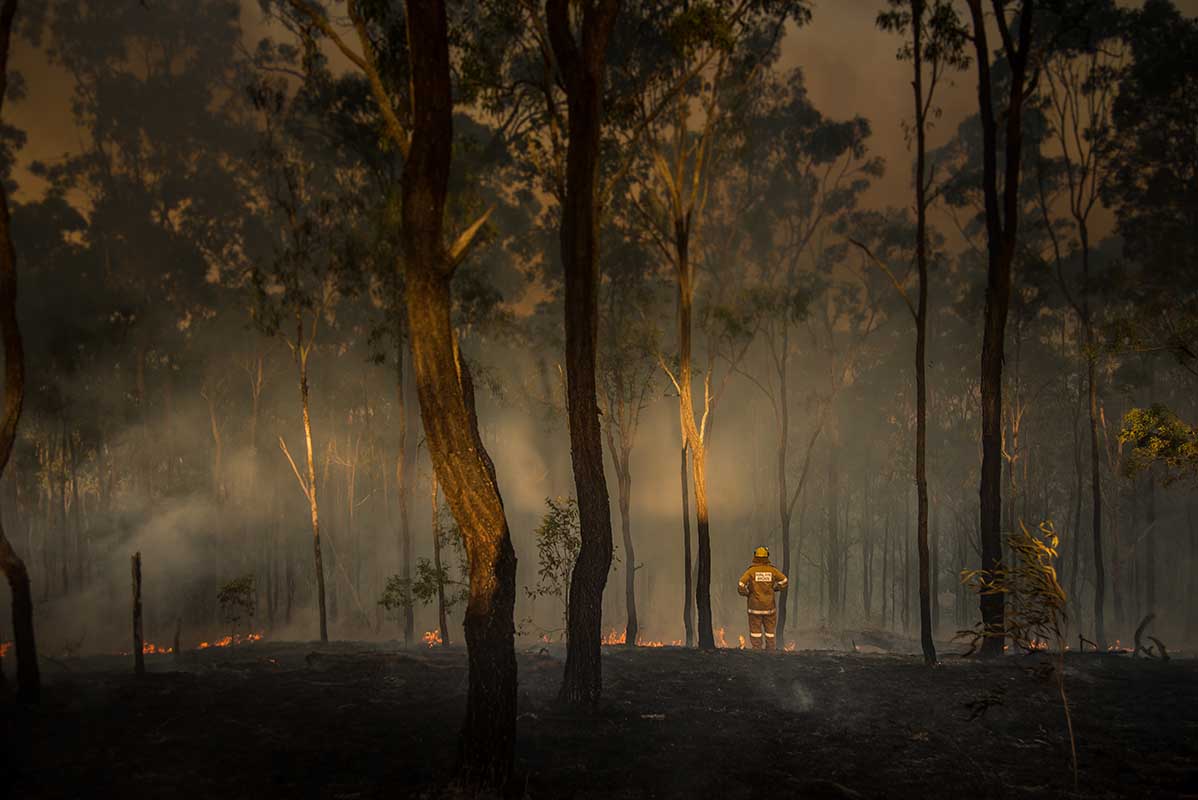
Recent research finds that climate change-induced drought is having a noticeable effect on the mortality rates of forests, even more so than recent bush fires
By Abigail Spink
Extreme heat, drought, and bushfires are inextricably linked in a destructive sequence. It is no coincidence that the year Australia experienced its hottest temperatures on record it also recorded rainfall levels at 40 per cent below average, and found itself battling the worst national bushfire season of all time.
While the fires were devastating, ravaging vegetation and wildlife alike, ecologists pinned hope on the ability of many tree species to recover after being burned. The first signs of regeneration came in February when small green branches began to emerge from blackened trunks and shrubs appeared from charred undergrowth. The eucalyptus or ‘gum’ tree, for example, an iconic feature of Australia’s physical landscape, has developed fire-resilience over millions of years and can actually flourish in the midst of a blaze.
In Firestorm: Surviving the Tasmanian Bushfire, the author Jon Henley documents some of these remarkable survival skills. ‘Some [species], like the mighty, 100-metre-tall Eucalyptus regnans – also known as the mountain ash, stringy gum or Tasmanian oak – hold their seeds inside small, hard capsules; a fire will instantly trigger a massive drop of seeds to the newly fertilised ground,’ he writes. ‘The myriad bright green buds that sprout spectacularly from the trunks of other eucalypts in the aftermath of a big fire are another kind of regeneration mechanism, bursting through the scorched and blackened bark within weeks of a blaze.’
Accounts such as these offer some reassurance to those concerned that Australia’s biodiversity will have a hard time bouncing back from the trauma. Scientists have argued, however, that trees can only recover if they are strong and healthy enough to do so. As droughts intensify as a result of climate change and become an increasingly familiar part of the Australian summer, trees are weakened by water stress and internal damage, so much so that they are often killed outright. Those that manage to survive periods of severe drought face little hope of withstanding the bushfires that frequently follow and essentially act as kindling for the flames.
According to Professor Tim Brodribb, lead author of a recent University of Tasmania-led review, Hanging by a thread? Forests and drought: ‘This [review] explains how trees die by breakage in their vascular systems, and how that will be more common in the future. In the context of the massive drought in Australia last year, which killed a lot more trees than the more recent fires, this is a sobering message.’

The paper notes that rising CO2 levels associated with an increase in global temperatures were once considered to be potentially beneficial to plant growth rates – ‘by stimulating photosynthesis or by increasing water-use efficiency’. However, this perspective has now shifted. ‘There has been a change in perspective over the past ten years, from expectations of enhanced forest growth under enriched atmospheric CO2 to the more sobering prospect of damage or decimation of standing forest caused by an increase in the drying rates of leaves and soil in a hotter climate,’ the researchers claim.
In other words, increasing heat and water shortages are contributing to a noticeable demise in tree health, a phenomenon also confirmed by researchers at the University of Melbourne. The University of Tasmania-led review maintains that ‘Tree mortality is most commonly observed when drought and high temperature are combined, likely owing to the […] increased porosity of leaves at high temperature’, meaning their ability to retain and effectively use water storages is considerably weakened.
The carbon-dense, woody skeletons of trees – essential for water and nutrient acquisition and transport – have been likened to corals, for their extreme sensitivity to environmental change and inflexible damage thresholds. Hydraulic failure, namely the inability of plants to move water from roots to leaves, and carbon starvation, the depletion of carbon stores as a result of stomata closure in response to drought, have been named as the two biggest causes of tree mortality and usually cause irreversible damage once they take hold.

Australia’s forests are undoubtedly hardy, but they face a very real threat. Unfortunately, there is no formal system in place to record tree deaths from drought. As a result, scientists launched ‘The Dead Tree Detective’ in 2018, a citizen science project which aims to record where and when trees have died across the country.
Brendan Choat, associate professor at the Hawkesbury Institute for the Environment at Western Sydney University, told ABC North and West SA last year that the tree deaths listed under the project had been unprecedented, highlighting swathes of dying hillside and the demise of ancient species such as sandalwood and eucalyptus. ‘Old-timers who have lived in these areas for a long time are saying they’ve never seen anything like this,’ he claimed.
While bushfires offer a very visual affirmation of destruction, drought causes gradual, but arguably more severe long-term damage. According to specialists, this requires a new level of scrutiny. Tim Brodribb from the University of Tasmania told Inside Climate News that most trees alive today will be dead within the next 40 years if temperatures and dryness increase as expected. ‘We really need to be able to hear these poor trees scream. These are living things that are suffering. We need to listen to them,’ he said.




